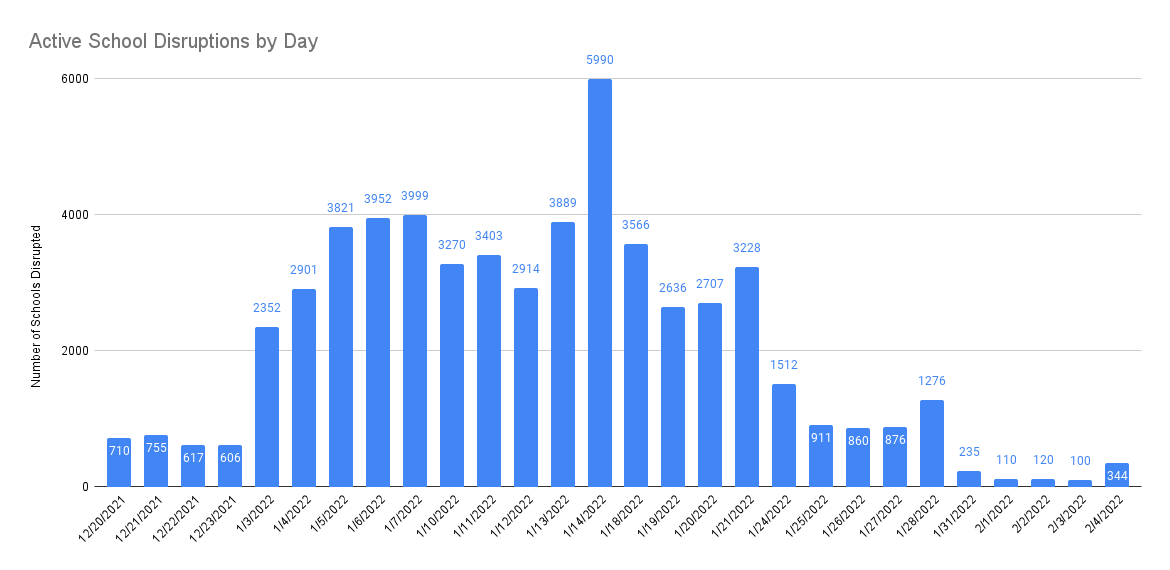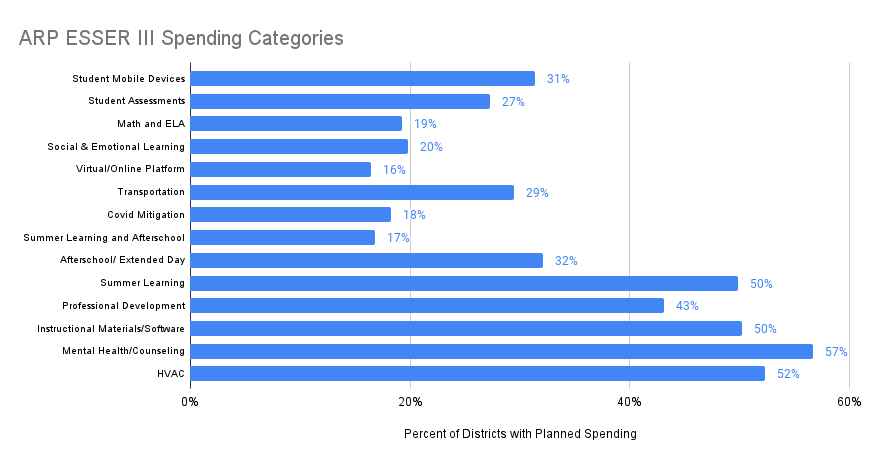Disruptions dropped dramatically this week to levels not seen since October. NCES published district level enrollment figures for 2020/21. This past week
the COVID 19 School Data Hub published an analysis of January 2022 school disruptions using Burbio's data, and
FutureEd continued their analysis of ESSER III spending using data from Burbio's research. More below.
1. This week the total number of schools that experienced at least one day of disruption dropped to 539, a drop of 74.7% versus last week's total of 2,128 and a drop of 92.8% from the yearly high of 7,462 the week of January 10th:
 |
2. The average number of schools disrupted per day last week was only 182 which, assuming 98,000 US K-12 public schools, indicates that 99.8% of US K-12 public schools were operating on any given day last week. Averages for the last five weeks, plus the updated daily chart:
Average Daily Disruptions For:
- Week of January 3rd: 3,405
- Week of January 10th: 3,893
- Week of January 17th: 3,034
- Week of January 24: 1,087
- Week of January 31st: 182
 |
3. In the Spring 2021, the Federal government authorized $122 billion in spending termed
"ESSER III'' allocated on the basis of Title I. Ninety percent of the spending goes directly to local districts. Burbio has tabulated over $64 billion in planned spending for 2,700+ districts across over 45 states, 57% of the US K-12 school population, by examining plans disclosed on source sites nationwide. Billions in school district planned spending are categorized and added weekly for partners who use it for market intelligence, advocacy work, and policy insight. We tabulate over 75 sub-categories. This week we revisit some of the categories identified most frequently in district plans:
 |
4. Last July, NCES announced that the academic 2020/21 year saw an enrollment drop versus the 2019/20 year, and this past week NCES issued finalized, district-by-district enrollment counts from last year. We'll be discussing 2021/22 enrollment trends in the coming months as these figures are made at the local level. Below are national and grade level trends through the 2020/21 school year:
Last August the New York Times ran a piece on declining enrollment for the 2020/21 year featuring results from a Stanford study that used Burbio's district-level data to examine enrollment trends in districts that offered different types of learning modalities. Further, this past December NPR ran a piece that surveyed 600 districts for 2021/22 enrollment trends and found enrollment drop-offs continuing this current year. Below are the grade level trends from the 2019/20 school year to the 2020/21 school year from the latest NCES report that point to the scale of the drop-off last year:
5. At districts across the country, universal contact tracing continues to be eliminated. Plus, the Super Bowl:
- The state of Oklahoma, in their announcement to reduce contact tracing cited this announcement from five national public health organizations. "While universal case investigation and contact tracing during the initial phase of the pandemic was justified in the attempt to contain the pandemic, most experts in public health agree this is no longer optimal . . . . We urge a refocus of our public health efforts and resources, with an emphasis on targeting investigations in higher risk settings serving vulnerable populations," reads the national group's announcement. Citing a range of factors from asymptomatic cases, the highest risk period of transmission being before symptoms appear, and the shorter incubation period of the Omicron variant, the report notes "only a very small portion of total cases and close contacts are being reached by public health contact tracers in time to prevent onward transmission."
- In our January 24th report we noted the trend of universal contact tracing being deemphasized in multiple states. This week, in addition to districts in Oklahoma, we note changes in North Carolina, Ohio, and Pennsylvania.
- Cincinnati Public Schools will be closed Monday, February 14th. "In honor of the Bengals' first Super Bowl appearance since 1989, CPS will not have school on Monday, February 14! Staff and students will have the day off to celebrate what we believe will be our city’s first-ever Super Bowl victory! #WhoDey," reads the District announcement.